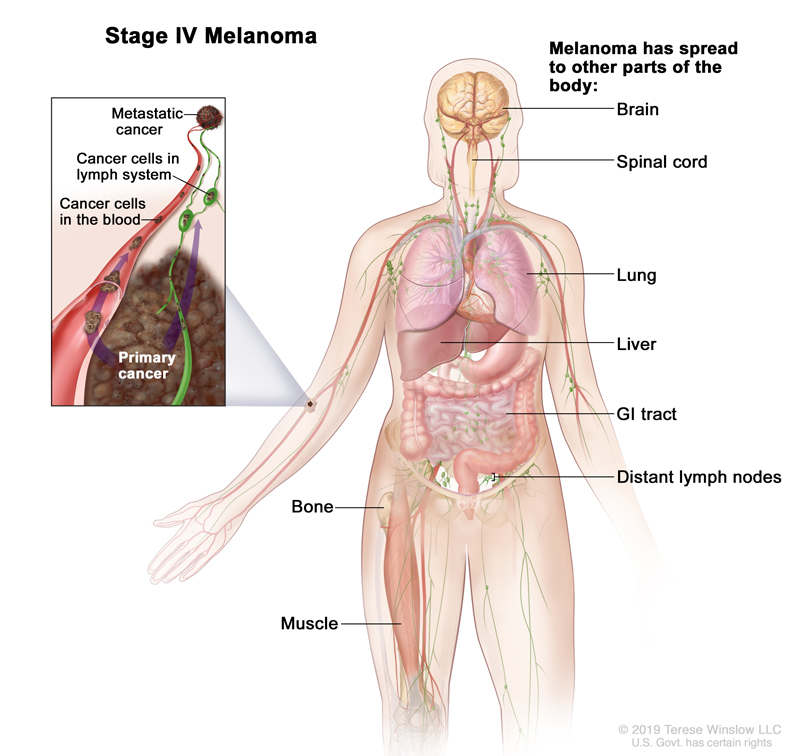Overview
Stage 4 Melanoma is a cancer that has spread from the original location in your skin to distant parts of your body.
Understanding your Stage 4 Melanoma diagnosis will help you partner with your doctors to make the best treatment choice for you. Tap “Watch Now” for an easy-to-understand overview of Stage 4 Melanoma.
- Stage 4 Melanoma
Overview
A Stage 4 Melanoma diagnosis means that the cancer has spread beyond your skin and closest lymph nodes, shown here in green, to distant organs in your body.
Common places the cancer spreads to are your brain, lungs, bones, liver, spinal cord, bone, soft tissue, including your muscles, your stomach and/or your distant lymph nodes.
What Tests Will I Need and Why?
Blood and Imaging tests are done to understand your general health, confirm your diagnosis and determine your cancer stage.
Tissue analysis is also typically done to identify the cancer cell type and BRAF mutation, which is critical to finding the best treatment option for you. BRAF mutation is present in 40-60% of all melanoma patients.
If your treatment team has not already performed tests to determine your cancer’s features, please ask your doctor when these tests will be performed.
Re-read this summary as needed and then tap, “Compare My Treatment Options Now“. Our unique Comparison Page will help you understand your FDA-approved treatment options including, who can help you pay for your treatment, where and how each is given and what side-effects you may experience.

National Institute of Health/ treatment-melanoma
Recommended Melanoma Cancer Videos

Understanding Melanoma
Causes, Staging & More

What Are The Stages of Melanoma?
Melanoma expert Jeffrey Weber, MD, PhD,

How Cancer Spreads
Metastastis

Diagnosing Your Cancer
How Does a CT Scan Work?

Diagnosing Your Cancer
How Does a PET Scan Work?

Exercise! You Can Do It
Reducing Side Effects & More
Commonly Searched Questions
Stage 4 Melanoma survival rate.
The five-year survival rate for stage 4 melanoma is 31.9%. That means 31.9% of people diagnosed with the disease are alive five years later.
Source: Cancer.gov
Stage 4 Melanoma symptoms.
Look for anything new, changing, or unusual on your skin, especially new moles. The ABCDE can help you detect Melanoma.
- A for asymmetry
- B for borders (uneven)
- C for color (multiple colors in one mole)
- D for diameter (larger than 6mm)
- E for evolving (size, shape, color, elevation of a spot on your skin)
Source: Skincancer.org
Is Stage 4 Melanoma brain cancer?
No, but patients with Stage 4 Melanoma can develop brain metastases.
Source: AimatMelanoma.org
Is Stage 4 Melanoma brain cancer?
No. Brain metastases are a specific form of Stage 4 Melanoma and are one of the most common and difficult-to-treat complications of melanoma. Brain metastases differ from all other metastases in terms of risk factors, diagnosis, and treatment.
Source: AimatMelanoma.org















